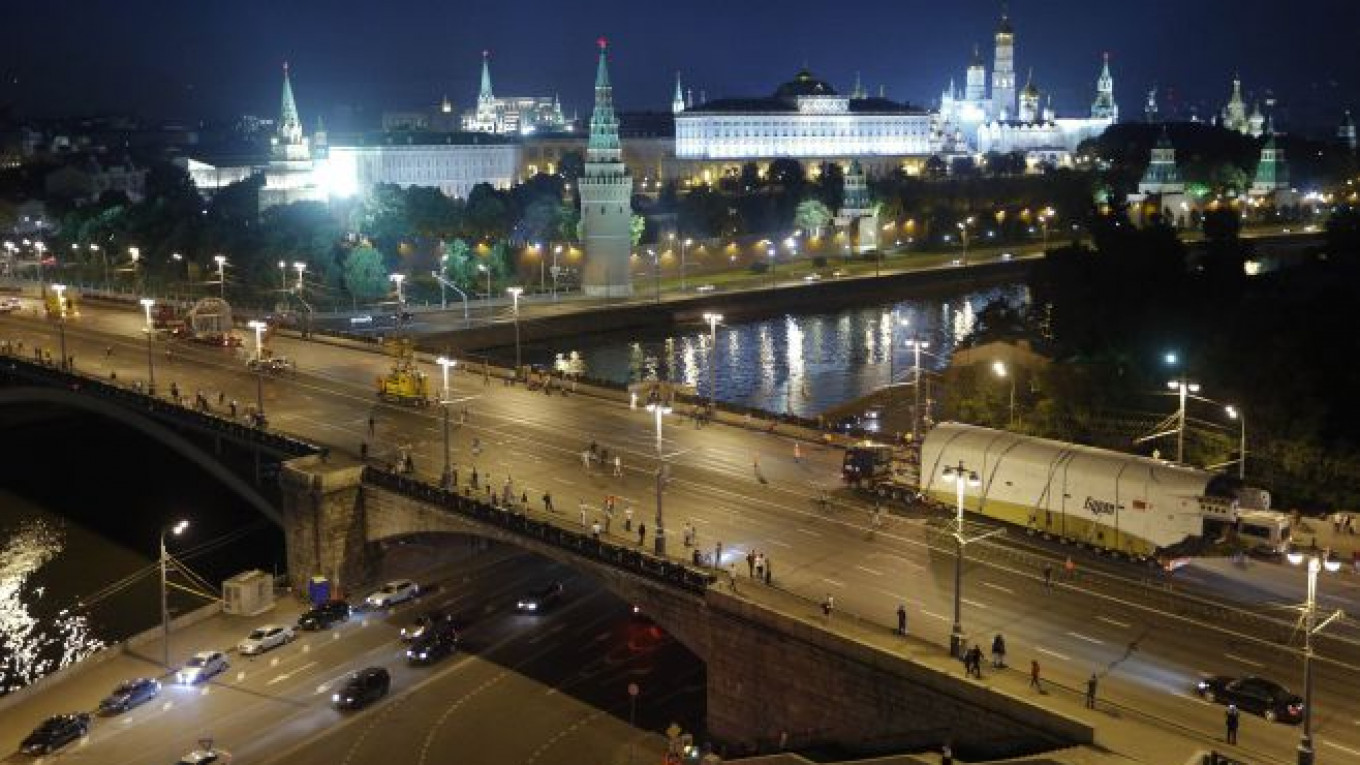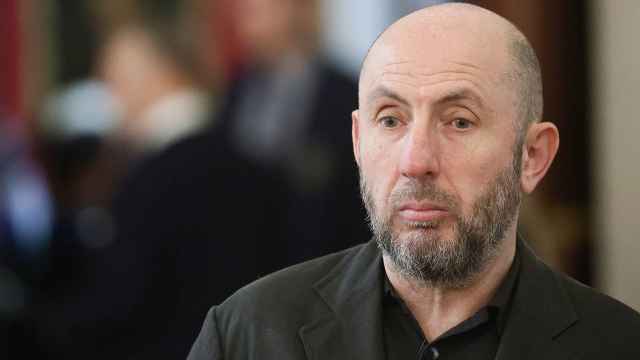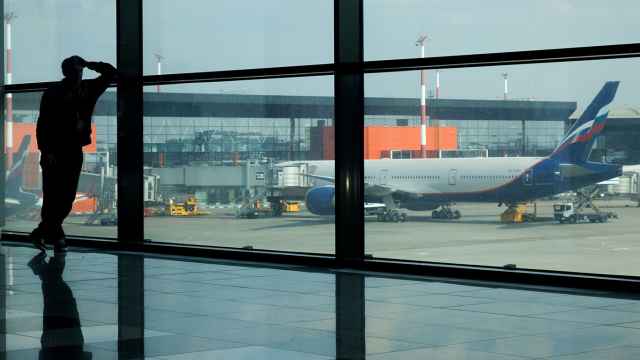The life-sized prototype of the Buran spaceship — a relic of the Soviet space industry's final breakthrough — was retired to its final resting place this weekend in Moscow's outdoor exhibition center, VDNKh.
On Saturday, the 50-ton space shuttle was relocated from the city center's Gorky Park, a prime hipster haunt, in what the city authorities described as an "unprecedented transportation operation."
The 36-meter-long Buran had to be dismantled for the nightly cruise across Moscow, which evoked images of a beached whale being carted away to its burial site, judging by photos from the operation.
The fantastic, albeit flawed, shuttle is expected to spend the rest of its days at VDNKh.
The Buran was an amazing piece of work, said test pilot Viktor Zabolotsky, one of the few people in the world who actually flew the Soviet space shuttle.
But it was a "white elephant" doomed to fail because of its exorbitant operation costs, Zabolotsky told The Moscow Times.
"Operating it would have been like using a KamAZ truck to transport a matchbox," he said in a telephone interview on Sunday.
Russia's flagging space industry has no immediate plans to revive the Buran.
It is too late anyway, as much of the technology has been lost and its developers have largely died off, said Nikolai Vedenkin of Russia's first private satellite maker Dauria Aerospace.
Taking On the Space Shuttle
Neither developers nor Politburo bosses made any effort to hide the fact that the Buran, or Blizzard, program was launched in response to NASA's Space Shuttle program, which the Soviet leadership believed had military capabilities.
But the Soviet space shuttle program turned out to be superior to its rival, said Yury Usachev, a Russian veteran cosmonaut who now sits on the selection commission for Russian cosmonaut candidates.
A central difference was the Buran's capability of automatic landing, demonstrated during its 205-minute maiden flight on Nov. 15, 1988. Its U.S. counterparts had to be landed manually.
The Buran also utilized a multipurpose Energia launcher, used arguably better thermal protection, had a bigger maximum payload and could stay in orbit twice as long as the US spacecraft.
However, the Buran never made it to space again after its maiden flight. The program, worth an estimated 16 billion rubles ($9.2 billion in 1988 prices) was mothballed after a couple of test runs within the earth's atmosphere — one of them by Zabolotsky — as state coffers were drained in the economic turmoil of perestroika.
The program was formally scrapped in 1993.
In 2002, the Buran that went to space met an anticlimactic end when it was destroyed by a collapsed roof of a storage facility at the Baikonur Cosmodrome. Several prototypes were scrapped or sold abroad. One prototype, made for acceleration and vibration testing, was moved to Gorky Park in 1995 and has since served as a moderately popular tourist attraction.
A Pyrrhic Success
The Buran program boasted undisputed achievements, such as the then-unique thermal protection materials, experts said.
"It was a superior system. No one had anything like it," Dauria's Vedenkin said.
But Usachev and Zabolotsky said the Buran was economically unfeasible.
The program utilized the resources of the entire Soviet Union, and was impossible for Russia to maintain alone after the communist state's demise, Usachev said. Up to 1 million people working with 1,200 organizations across the Soviet Union were involved in Buran's development.
Buran was also too costly to fly, Usachev and Zabolotsky said. Official launch costs were never disclosed, but the U.S. Space Shuttle had a similar problem, with a launch cost of about $450 million, which led to its decommissioning in 2011, after 30 years of service.
There was also simply not enough scientific equipment to send into orbit, Zabolotsky said.
"It was a major mistake," Zabolotsky said of the Buran. Although Zabolotsky does not regret the fact that he never had the opportunity to fly the Buran into space, he admitted to having enjoyed testing the unique machine.
The Buran program had one real objective — to show that Russia was still a match for the U.S. in space technology — and that objective was fulfilled, Usachev said.
No Going Back
Russia has been striving to revive its space industry in recent years, following more than a decade of neglect.
The Federal Space Agency's budget stands at 165 billion rubles ($4.8 billion) this year, up from 49 billion rubles in 2005 ($1.8 billion in 2005 prices).
But the program remains plagued by failures and botched launches. Just last week, the maiden flight of the much-touted Angara carrier rocket was canceled twice because of various malfunctions.
Buran's tentative replacement, the Clipper, had been in the works since 2000, but was scrapped in 2006. Another, unnamed reusable spacecraft is now in development, but little progress has been reported so far.
The situation raised the question of a possible return to Buran, an undisputed technological achievement despite its flaws.
But all experts interviewed for this article said they expected the Buran to rest in peace at the VDNKh — though they differed about the reasons for it.
"Its time has passed. We have shown we can do it, but the return of the Buran is impossible — and useless," Usachev said.
But Vedenkin of Dauria said the program could be revived if only the management of the Russian space industry had the will for it — which they don't.
"They all want instant gratification … and it would take at least 15 years to bring the Buran back," he said.
Contact the author at [email protected]
A Message from The Moscow Times:
Dear readers,
We are facing unprecedented challenges. Russia's Prosecutor General's Office has designated The Moscow Times as an "undesirable" organization, criminalizing our work and putting our staff at risk of prosecution. This follows our earlier unjust labeling as a "foreign agent."
These actions are direct attempts to silence independent journalism in Russia. The authorities claim our work "discredits the decisions of the Russian leadership." We see things differently: we strive to provide accurate, unbiased reporting on Russia.
We, the journalists of The Moscow Times, refuse to be silenced. But to continue our work, we need your help.
Your support, no matter how small, makes a world of difference. If you can, please support us monthly starting from just $2. It's quick to set up, and every contribution makes a significant impact.
By supporting The Moscow Times, you're defending open, independent journalism in the face of repression. Thank you for standing with us.
Remind me later.







